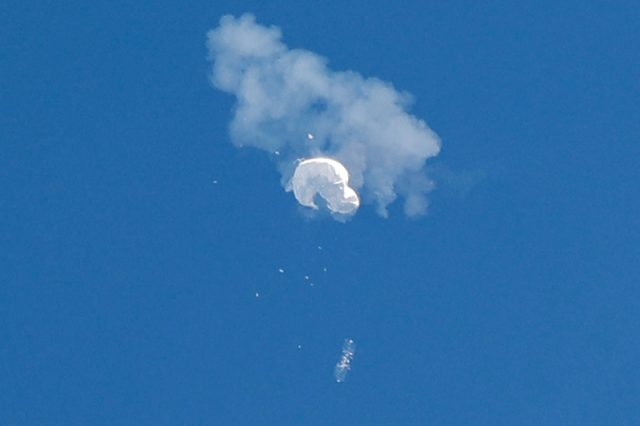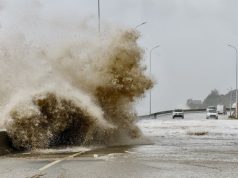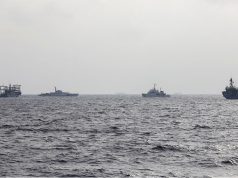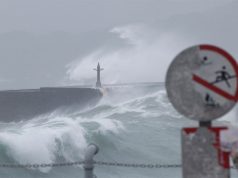
SHANGHAI— The U.S. shooting down of what Washington says was a Chinese spy balloon and Beijing says was a civilian scientific vessel accidentally blown off course has fuelled widespread questions, including about the balloon itself.
More is likely to be learned about the balloon after the U.S. military recovers its remnants from the ocean off the coast of South Carolina.
READ: China’s balloon over the U.S. seen as bold but clumsy espionage tactic
Here’s what we know, and don’t know, about the balloon that has triggered a dramatic diplomatic dispute between the two powers:
How big is it?
The head of North American Aerospace Defence Command, General Glen VanHerck, described the balloon as being 200 feet (61 metres) high, with a surveillance payload the size of a regional passenger jet that likely weighed in excess of a couple thousand pounds.
Civilians viewing the balloon from the ground described it as a giant white orb as it floated about 60,000 feet (18,300 meters) above the central United States, an altitude roughly twice that of civilian air traffic.
U.S. officials said they had been tracking the high-altitude for some time and that it drifted over the United States for at least seven days.
What has China said?
China’s foreign ministry said the balloon was mainly used for meteorological purposes and had limited self-steering ability. It said it was affected by the weather and unexpectedly drifted into U.S. airspace.
The ministry has also said it has no information to share about what company or entity owns the balloon.
Was it a weather balloon?
Kaymont, a U.S. firm that makes and distributes weather balloons globally, said the size, payload and flight time exceeded the capabilities of typical weather balloons that are made of latex.
“A typical weather forecasting balloon will have a lightweight radiosonde payload that is about 200 grams in weight. The balloon at release will be about 1.4 metres and will burst around 6 metres in diameter, and the flight time will be between 90-120 minutes,” Jesse Geffen, a Kaymont account manager, told Reuters.
“Photographic payloads (high altitude photography and videography) may be carried by larger balloons, but wouldn’t even be a third of the size of the balloon that flew over the country.”
In China, the manufacture of weather balloons is dominated by a subsidiary of state chemical giant ChemChina, Zhuzhou R&D Institute for Rubber & Plastics (Zhuzhou Rubber), which makes 75% of high-altitude balloons used by the China Meteorological Administration, the country’s regulator of state-owned firms said in a statement last year.
Smaller players include Guangzhou Double-One Weather Equipment Company, whose company’s chairman Lin Xiuping told Reuters that her firm and Zhuzhou Rubber were capable of making balloons that could fly at the height the Chinese balloon was flying at over the United States.
She said, however, that Guangzhou Double-One was not the manufacturer of that balloon.
An employee that answered the phone at Zhuzhou Rubber’s headquarters said the U.S. balloon had nothing to do with the company and declined to accept further questions.
So what kind of balloon is it?
Kaymont said the balloon was likely made of plastic film, not latex. Some descriptions thus far of the balloon debris being retrieved from the Atlantic Ocean say that there has been plastic.
By looks and by size, it resembles balloons made by U.S. firm Aerostar, whose own balloon was mistaken for the Chinese one while flying over Memphis.
Aerostar is an aerospace and defence contractor that supplies stratospheric balloons to the likes of National Aeronautics and Space Administration (NASA) made out of polyethylene film that can fly for over 200 days and carry hundreds of pounds.
It also previously had a deal with Google to use such balloons to provide internet to rural areas.
Other companies that develop stratospheric balloon systems include U.S. space tourism firm World View and French firm CNIM Air Space.
China does not appear to have a private company equivalent, but the official Chinese Academy of Sciences’ Aerospace Information Research Institute (AIR) and Institute of Optoelectronics have both conducted significant research on stratospheric balloons and published accounts of launches.
In 2017, for example, the Institute of Optoelectronics announced it had successfully flown a “super pressure” balloon it had developed in Inner Mongolia, describing it as having a volume of 7,000 cubic meters and able to carry 150 kilograms.
Last September, China’s AIR announced the successful trial of a balloon that can reach heights of 30 km and carry up to 1.2 tonnes as part of a project for developing near-space technologies.
AIR is particularly keen on stratospheric balloon technology and has posted several articles on its WeChat account about Aerostar.
Reuters was not able to immediately establish what firms supply AIR or the Institute of Optoelectronics with their balloons.
Both institutes did not respond to requests for comment.
Chinese military researchers have recently argued in publicly-available papers that balloons and airships should be further developed and deployed across a range of missions, Reuters reported on Monday.
While analysts did not yet know the size of the Chinese balloon fleet, U.S. officials have spoken of dozens of missions since 2018 across five continents, with some targeting Japan, India, Vietnam, Taiwan and the Philippines.
—Reporting by Brenda Goh, Albee Zhang and Eduardo Baptista; Additional reporting by Shanghai Newsroom; Editing by Kim Coghill









